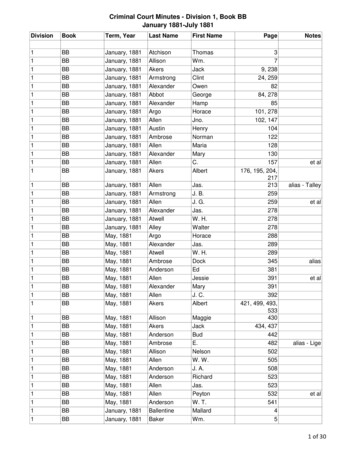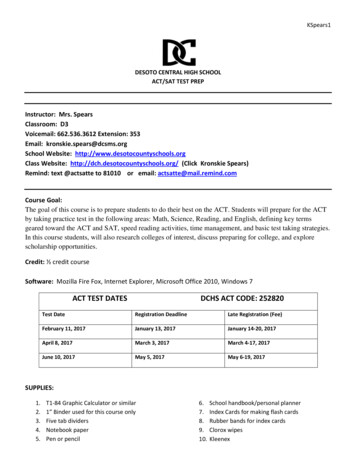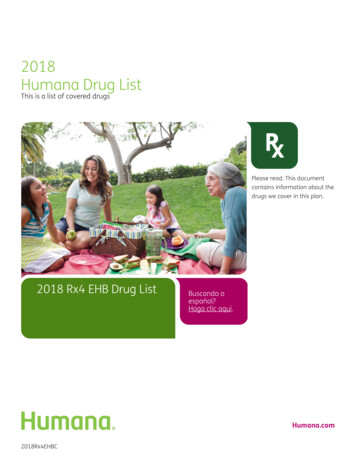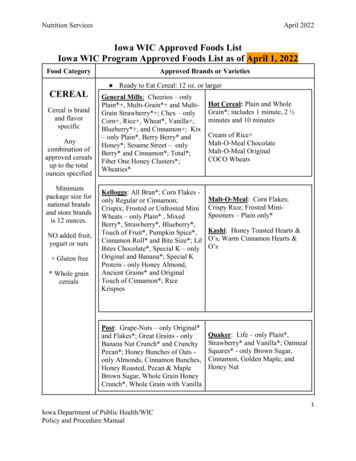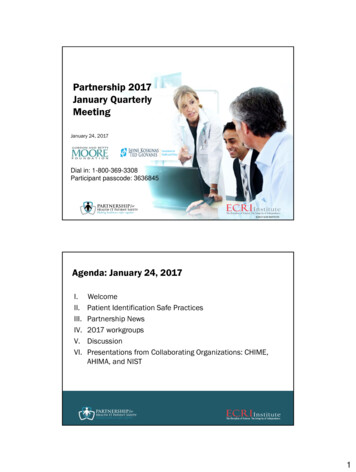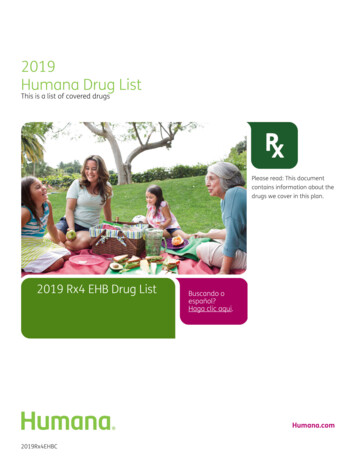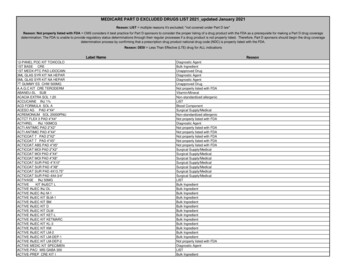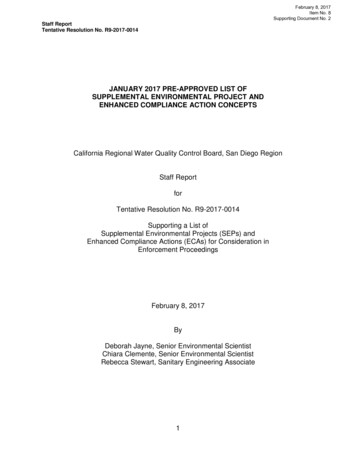
Transcription
February 8, 2017Item No. 8Supporting Document No. 2Staff ReportTentative Resolution No. R9-2017-0014JANUARY 2017 PRE-APPROVED LIST OFSUPPLEMENTAL ENVIRONMENTAL PROJECT ANDENHANCED COMPLIANCE ACTION CONCEPTSCalifornia Regional Water Quality Control Board, San Diego RegionStaff ReportforTentative Resolution No. R9-2017-0014Supporting a List ofSupplemental Environmental Projects (SEPs) andEnhanced Compliance Actions (ECAs) for Consideration inEnforcement ProceedingsFebruary 8, 2017ByDeborah Jayne, Senior Environmental ScientistChiara Clemente, Senior Environmental ScientistRebecca Stewart, Sanitary Engineering Associate1
February 8, 2017Item No. 8Supporting Document No. 2Staff ReportTentative Resolution No. R9-2017-0014Table of ContentsIntroduction3SEP/ECA Project Solicitation4Project Evaluation Methodology5Results and Recommended List6Pre-Approved SEP/ECA Concept List Availability6Adding to SEP/ECA List -- Continuous Solicitation and List Update6Third Party Administration of SEP/ECA List and Project Management6“January 2017 Pre-Approved SEP/ECA Concept List”7SEP/ECA Projects Categorized as “Contingent” and “Not Eligible”112
February 8, 2017Item No. 8Supporting Document No. 2IntroductionThe Porter-Cologne Water Quality Control Act (Porter-Cologne Act, California WaterCode, Division 7) authorizes the Regional Water Boards to impose administrative civilliabilities (i.e. monetary penalties) for water quality violations alleged in anAdministrative Civil Liability (ACL) Complaint. Pursuant to the State Water ResourcesControl Board’s (State Water Board) Policy on Supplemental Environmental Projects(2009 SEP Policy), SEPs are defined as projects that enhance the beneficial uses of thewater of the San Diego Region, provide a benefit to the public at large, and (at the timethey are included in the resolution of an ACL action) are not otherwise required of thedischarger. SEPs are intended to restore the environmental harm resulting from theviolation(s) alleged. Pursuant to the State Water Board’s Water Quality EnforcementPolicy (2010 Enforcement Policy), ECAs are defined as projects that enable adischarger to make capital or operational improvements beyond those required by lawand are separate from projects designed to merely bring a discharger into compliance.ECAs are intended to prevent additional or future impacts to beneficial uses and aretypically proposed by municipalities.In accordance with Government Code section 11415.6 and the statewide SEP andEnforcement Policies, dischargers that have been assessed an ACL by a Water Boardmay choose to satisfy up to 50 percent of their total liability by funding an eligible SEPor ECA. That portion of the liability (i.e., SEP or ECA dollar amount) is suspended untilthe discharger can demonstrate successful completion of the proposed project, at whichtime it is dismissed. A discharger can either conduct the SEP or ECA itself, or contractwith a third party for completion of the project.In October 2015, Assembly Bill 1071 was signed into law requiring, in part, that allboards, departments, and offices within CalEPA that have enforcement authority,develop an annual SEP list designed to benefit environmental justice (EJ) communitiesand disadvantaged communities (DACs).In November 2013, the San Diego Regional Water Quality Control Board (San DiegoWater Board) adopted "Resolution No. R9-2013-0153, A Resolution in Support of theSan Diego Water Board Practical Vision, titled "Healthy Waters, Healthy People.”Through the adoption of this Practical Vision, the San Diego Water Board establishedfive regional priorities to pursue through the year 2020. These five priorities include (1)making the best possible use of resources for the purpose of protecting the health ofRegion’s water; (2) implementing the “Framework for Monitoring and Assessment in theSan Diego Region”; (3) advancing the Recovery of the Region’s Stream, Wetland andRiparian Systems; (4) conducting Proactive Public Outreach and Communication withan emphasis on outreach to EJ and DACs; and (5) achieving a Sustainable Local WaterSupply.3
February 8, 2017Item No. 8Supporting Document No. 2Staff ReportTentative Resolution No. R9-2017-0014The San Diego Water Board has subsequently adopted a series of supportingresolutions that generally serve to confirm, emphasize, and further explain the overallregional priorities it established in the Practical Vision. For purposes of this resolution,the three most relevant are: (1) Resolution R9-2015-0020 in Support of FundingProjects that Further the Practical Vision Priorities with Consideration to EnvironmentalJustice and Disadvantaged Communities and the Recovery of Stream, Wetland, andRiparian Systems; (2) Resolution R9-2015-0041 to Support Restoration of AquaticEcosystems in the San Diego Region; and (3) Resolution R9-2016-0200 endorsing the2016 Community Outreach Strategy: Proactive Public Outreach and Communication.To promote the San Diego Water Board’s established regional priorities, meet the intentof Assembly Bill 1071, and facilitate use of high quality SEPs and ECAs, staff developedthe “January 2017 Pre-Approved SEP/ECA Concept List,” hereinafter “SEP/ECA List”(Supporting Document 3 in agenda materials). The SEP/ECA List will assistenforcement proceedings by presenting interested dischargers with a list of project"concepts" that have been reviewed and pre-approved by the Board’s Prosecution andAdvisory Team representatives independent of, and in advance of, any specific penaltyaction. Although the projects on the SEP/ECA List have been pre-approved in conceptby the San Diego Water Board or its delegate, if selected by a discharger, the projectproposal may require significant augmentation to reflect issues such as timing, cost, andnexus relative to the specific settlement order; all of which remains subject to the WaterBoard’s ultimate and final approval.SEP/ECA Project SolicitationIn developing the Water Board’s SEP/ECA solicitation and application materials, staffestablished six basic “Eligibility Requirements” (a.k.a., eligibility criteria) specificallydesigned to reflect the Regional Water Board’s established priorities and State WaterBoard policies.1. Does the project address an environmental justice (EJ) issue or benefit adisadvantaged community (DAC)?2. Does the project address DAC water related infrastructure needs?3. Does the project promote preservation or restoration of aquatic ecosystems inthe San Diego Region?4. Does the project implement or further the recovery of streams, wetlands, andriparian systems?5. Does the project implement or further the monitoring and assessment frameworkin Chapter 2 of the San Diego Water Board’s Practical Vision?6. Does the project implement or further a strategy for achieving a sustainable localwater supply?4
February 8, 2017Item No. 8Supporting Document No. 2Staff ReportTentative Resolution No. R9-2017-0014On June 23, 2016, the San Diego Water Board officially announced its “Call for SEPand ECA Proposals” for possible inclusion on the Board’s upcoming SEP/ECA List. Thesolicitation and application materials were posted on the Water Board website anddistributed and consisted of (1) Revised Project Application Form; (2) ApplicationChecklists (consisting of “Eligibility Requirements”, “Project Attributes”, and “ApplicantAttributes”); and "SEP/ECA Q&A” (Supporting Document 5 in the agenda materials).The four-month solicitation period closed on October 20, 2016.In addition to web posting and routine notification of all known interested parties, theSan Diego Water Board also conducted a SEP/ECA Public Workshop on July 19, 2016.The workshop was designed to inform the public and EJ Communities about thesolicitation and application materials, as well as the Board’s selection priorities as statedin the Eligibility Requirements. At the July 19, 2016 SEP/ECA Public Workshop, staffoffered one-on-one proposal writing assistance to anyone developing a SEP or ECAthat would specifically benefit EJ or DACs. In addition, staff announced the SEP/ECASolicitation/Call for Projects at a well-attended July 2016 environmental justiceworkshop on climate change in Barrio Logan, as well as at several community outreachmeetings that the San Diego Water Board held with stakeholders throughout theRegion.Project Evaluation MethodologyThe San Diego Water Board received a total of 42 timely applications, of which 13proposed projects would directly benefit EJ or DACs. After a preliminary review forcompleteness and compliance with the Eligibility Requirements, each application wasindependently evaluated by each member of the Review Team (comprised ofrepresentatives from both the Board’s Prosecution and Advisory Teams). Proposedprojects were evaluated based on how well they matched the desirable “ProjectAttributes” and “Applicant Attributes” stated in the Application Checklists. Afterindependent evaluation, the Review Team convened for a group discussion of eachapplication and to develop a consensus recommendation.Every application was placed into one of the four following categories: (1) StronglySupport; (2) Support; (3) Contingent; and (4) Not Eligible. Applications listed in the firsttwo categories, “Strongly Support” and “Support” comprise the staff’s recommendedJanuary 2017 SEP/ECA List. Applications in the “Contingent” category were deemed toneed additional information or commitment in order to complete the evaluation, and arebeing returned to the applicants for augmentation. Contingent applications may beresubmitted to the San Diego Water Board in the future provided that the statedcontingency is adequately addressed. Applications in the “Not Eligible” category mayalso be re-submitted in the future provided that the stated basis for ineligibility isadequately addressed. In the case of the latter two categories, the proponents arewelcome to augment and resubmit their applications for future consideration.5
February 8, 2017Item No. 8Supporting Document No. 2Staff ReportTentative Resolution No. R9-2017-0014Results and Recommended ListStaff’s recommended January 2017 SEP/ECA List is comprised of the 25 proposedprojects categorized as “Strongly Support” and “Support,” 8 of which directly benefit EJor DACs, and 4 of which benefit the Tijuana River Valley. Twelve of the applicationsreceived were categorized as “Contingent,” of which 5 would likely benefit EJ or DACs,with 2 benefitting the Tijuana River Valley. Five of the applications received weredeemed “Not Eligible” at this time.Pre-Approved SEP/ECA Concept List AvailabilityUpon adoption of Resolution, R9-2017-0014, the approved January 2017 SEP/ECA Listwill be posted on the Water Board’s website along with links to each proposal’s fullapplication. At that time, the SEP/ECA List and project applications will be available forreview by interested dischargers and the public alike.Adding to SEP/ECA List -- Continuous Solicitation and List UpdateStaff anticipates that maintaining and keeping the SEP/ECA List up-to-date (i.e., addingnew projects) will be resource intensive. Because project ideas are constantly evolving,it would be most efficient to allow ongoing maintenance and updating of the SEP/ECAList in the future. This administrative streamlining would allow the San Diego WaterBoard to accept, review, and add new projects to the SEP/ECA List. Project proposalswill be logged in as received and reviewed as resources allow. If after a thoroughreview, using similar eligibility requirements and selection methodology (to theevaluation process described herein), the Review Team recommends that a newproject(s) be added to the SEP/ECA List, the Review Team may request that theExecutive Officer approve the recommended project(s). Upon Executive Officerapproval, the newly approved project(s) will be added to the SEP/ECA List.Third Party Administration of SEP/ECA List and Project ManagementThe use of a third party administrator could be of great benefit and time savings to theSan Diego Water Board. As an example, in Region 5, a third party administrator undercontract with the State is responsible for the collection and deposition of SEP and ECAfunds into an interest-bearing escrow account. The aggregated funds are then madeavailable for funding select SEP and ECA projects. This service is provided inexchange for an added overhead fee, and in the case of Region 5, includes projectmanagement, routine accounting, and progress and final reporting to their RegionalWater Board.The San Diego Water Board could seek a third-party administrator for the followingcontractual objectives:1. Allow SEP/ECA checks to be written directly to the third party administrator whoassumes liability from the discharger;2. Allow the third party administrator to deposit and aggregate SEP/ECA funds in aninterest bearing account and distribute funds as deemed appropriate for thepurpose of funding SEP and ECA projects specifically approved by the SanDiego Water Board, or its delegate;6
February 8, 2017Item No. 8Supporting Document No. 2Staff ReportTentative Resolution No. R9-2017-00143. Manage ongoing SEP and ECA projects including providing oversight,accounting, and quarterly and final reporting to the San Diego Water Board;4. Solicit for and propose new SEP/ECA projects for San Diego Water Board (ordelegate) approval; and5. Manage and update (i.e., add new approved projects to) the SEP/ECA List asauthorized by the San Diego Water Board (or its delegate).Although staff has begun a search for a suitable third party with which to contract forthis purpose, no party is recommended at this time. At such time as a suitable party isidentified, staff would develop appropriate contract language in consultation with legalcounsel and the third party.“January 2017 Pre-Approved SEP/ECA Concept List”The “January 2017 Pre-Approved SEP/ECA Concept List” is presented below and inSupporting Document 3 of the agenda materials.7
January 2017 List of pre-approved SEPs and ECAsSan Diego Regional Water Quality Control BoardSEP NumberWatershed/Hydrologic UnitFebruary 8, 2017Item No. 8Supporting Document No. 2Project NameSTRONGLY SUPPORTSEP2016-0020San Juan CreekSan Juan Creek Estuary Restoration Opportunities AssessmentSEP2016-0018San Luis Rey RiverThe Septic System Maintenance and Best Management Practices Rebate ProgramSEP2016-0008Los Peñasquitos CreekLos Peñasquitos Lagoon Inlet Restoration ProjectSEP2016-0035Mission BayReWild Mission BaySEP2016-0036San Diego RiverSan Diego River Restoration and MonitoringSEP2016-0009Otay River/Sweetwater RiverOcean Connectors Habitat Restoration and Education ProgramSEP2016-0015Tijuana RiverTijuana River Watershed Sediment Management PlanProjects in Bold and Italic are located in Environmental Justice/Disadvantaged Communites
January 2017 List of pre-approved SEPs and ECAsSan Diego Regional Water Quality Control BoardSEP NumberWatershed/Hydrologic UnitFebruary 8, 2017Item No. 8Supporting Document No. 2Project NameSUPPORTSEP2016-0040RegionwideEvaluating BMP Effectiveness for Human PathogensSEP2016-0041RegionwideCreating Tools to Assess Adverse Effects of Organic Matter Pollution on EstuarineSedimentSEP2016-0003Laguna Coastal Streams; AlisoCreek; Salt Creek; San JuanCreek; San Clemente CoastalStreams; San Mateo CreekCleanup OCSEP2016-0010Santa Margarita RiverSanta Margarita River Estuary Water Quality and Habitat AssessmentSEP2016-0017San Luis Rey RiverThe Conservation Plans and Nutrient Reduction BMPs Implementation ProgramSEP2016-0019San Luis Rey RiverSan Luis Rey Watershed Non-Native Plant ControlSEP2016-0022San Luis Rey RiverMonitoring the Health of Our Waters through Bioassessment-San Luis ReySEP2016-0007Escondido CreekEscondido Creek Invasive Plant RemovalSEP2016-0023Carlsbad HUMonitoring the Health of Our Waters through Bioassessment-CarlsbadProjects in Bold and Italic are located in Environmental Justice/Disadvantaged Communites
January 2017 List of pre-approved SEPs and ECAsSan Diego Regional Water Quality Control BoardSEP NumberWatershed/Hydrologic UnitFebruary 8, 2017Item No. 8Supporting Document No. 2Project NameSUPPORTSEP2016-0011San Dieguito RiverSan Dieguito River Invasive Plant Removal and RestorationSEP2016-0024San Dieguito HUMonitoring the Health of Our Waters through Bioassessment-San DieguitoSEP2016-0025Peñasquitos HUMonitoring the Health of Our Waters through Bioassessment-PenasquitosSEP2016-0026San Diego HUMonitoring the Health of Our Waters throught Bioassessment-San Diego RiverSEP2016-0029Otay HUMonitoring the Health of Our Waters through Bioassessment-OtaySEP2016-0027Pueblo San Diego HUMonitoring the Health of Our Waters through Bioassessment-PuebloSEP2016-0028Sweetwater HU; Otay HU;Tijuana HUMonitoring the Health of Our Waters through Bioassessment-Sweetwater, Otay, TijuanaSEP2016-0030Tijuana HUMonitoring the Health of Our Waters through Bioassessment-TijuanaSEP2016-0034Tijuana RiverTreatment of Tamarisk within the Tijuana Slough National Wildlife RefugeProjects in Bold and Italic are located in Environmental Justice/Disadvantaged Communites
Staff ReportTentative Resolution No. R9-2017-0014SEP/ECA Projects Categorized as “Contingent” and “Not Eligible”Project proposals placed into the “Contingent” and “Not Eligible” categories are shownbelow and in Supporting Document 4 of the agenda materials.11
PROPOSED JANUARY 2017 CONTINGENT PROJECTS (R9)SEP NumberWatershed/HydrologicUnitProject NameSEP2016-0006RegionwideButts to Watts Cigarette LitterPrevention and Recycling ProgramInclude long term maintenance commitment by the discharger.Include justification of recycling cost or reduce.Only sites within EJ communities will be considered for funding.Aliso Creek Mainstem EcosystemRestoration ProjectDemonstrate project is a viable restoration project with waterquality benefits through 401 process.Only willing to fund restoration components.Include support from interested parties.Consider including functional assessment success criteria.Consider augmenting with treatment control best managementpractices.ContingenciesSEP2016-0039Aliso CreekSEP2016-0016Agua HediondaCreekSEP2016-0012Los PenasquitosCreekLos Peñasquitos Lagoon Phase 1ADemonstrate illicit sediment and dry weather flows from thewatershed have been eliminated prior to inclusion on the list.SEP2016-0013Los PenasquitosCreekLos Peñasquitos Lagoon Phase 1BDemonstrate illicit sediment and dry weather flows from thewatershed have been eliminated prior to inclusion on the list.Justify and describe survey area.Caulerpa Taxifolia Monitoring-InnerDemonstrate how this project will coordinate with dredgingBasin, Agua Hedionda Lagoonsurveys.Projects in Bold and Italic are located in Environmental Justice or Disadvantaged Communities
PROPOSED JANUARY 2017 CONTINGENT PROJECTS (R9)SEP NumberSEP2016-0032Watershed/HydrologicUnitSan Diego RiverProject NameDemonstrate project is a viable restoration project with waterquality benefits through 401 process.Only willing to fund restoration components.Include support from interested parties.Las Colinas Channel ImprovementsConsider including functional assessment success criteria.Include a discussion of all existing treatment control bestmanagment practices to treat trash and WQIP listed prioritypollutants in the project watershed (or service) area.SEP2016-0033San Diego RiverSycamore Creek RestorationSEP2016-0042San Diego RiverFamosa Slough Storm Drain PipeSEP2016-0037San Diego BayContingenciesDemonstrate project is a viable restoration project with waterquality benefits through 401 process.Include support from interested parties.Consider including functional assessment success criteria.Include a discussion of all existing treatment control bestmanagement practices designed to treat trash and WQIP listedpriority pollutants in the project's watershed (or service) area.City of San Diego needs to be a coapplicant for modification to theirmunicipal storm sewer system.Demonstrate project is a viable restoration project with waterquality benefits through 401 process.Include support from interested parties.Paradise Creek Restoration Project atConsider including functional assessment success criteria.Highland AvenueInclude a discussion of all existing treatment control BMPsdesigned to treat trash and WQIP listed priority pollutants in theproject's watershed (or service) area.Projects in Bold and Italic are located in Environmental Justice or Disadvantaged Communities
PROPOSED JANUARY 2017 CONTINGENT PROJECTS (R9)SEP NumberWatershed/HydrologicUnitSEP2016-0038San Diego BaySEP2016-0014Tijuana RiverSEP2016-0002Tijuana RiverProject NameContingenciesConfirm that RGP 63 mitigation requirements have been fulfilled.Demonstrate project is a viable restoration project with waterqualty benefits through 401 process.Paradise Creek Restoration Project atConsider including functional assessment criteria.West AvenueInclude a discussion of all existing treatment control bestmanagement practices designed to treat trash and WQIP listedpriority pollutants in the project's watershed (or service) area.Tijuana River Valley PropertyAcquisition/RestorationInclude commitment for long-term maintenance on purchasedproperties.Add co-applicant that will be responsible for operation andTijuana River Floating Trash Capturemaintenance after installation.SystemInclude additional justification for non-construction costs.Projects in Bold and Italic are located in Environmental Justice or Disadvantaged Communities
PROPOSED JANUARY 2017 PROJECTS NOT ELEGIBLE (R9)SEP NumberWatershed/Hydrologic UnitProject NameBasis for InelegibilitySEP2016-0001Aliso CreekAliso Creek Urban Runoff Education & ReductionActivities identified are legally required of themunicipal storm water co-permittee.SEP2016-0004Dana Point HarborDana Point Harbor Copper Reduction ProgramSuccess criteria is insufficent to demonstratewater quality benefits.SEP2016-0005San Mateo Creek; SanClemente Coastal Streams;Dana Point Coastal Streams;San Juan CreekSEP2016-0021RegionwideSEP2016-0031Escondido CreekWHALES: Watershed Heros-Actions LinkingSuccess criteria is insufficent to demonstrateEducation to Stewardship, South Orange County water quality benefits.The Industrial General Permit EducationalWorkshopIndustrial General Permit trainings areplanned and conducted by the State WaterResources Control Board.Master Drainage Facility Condition Assessment and Activities identified are legally required of theReplacementmunicipal storm water co-permittee.Projects in Bold and Italic are located in Environmental Justice or Disadvantaged Communites
Policy (2010 Enforcement Policy), ECAs are defined as projects that enable a discharger to make capital or operational improvements beyond those required by law and are separate from projects desig ned to merely bring a discharger into compliance. ECAs are intended to . prevent. additional or future impacts to beneficial uses and are
